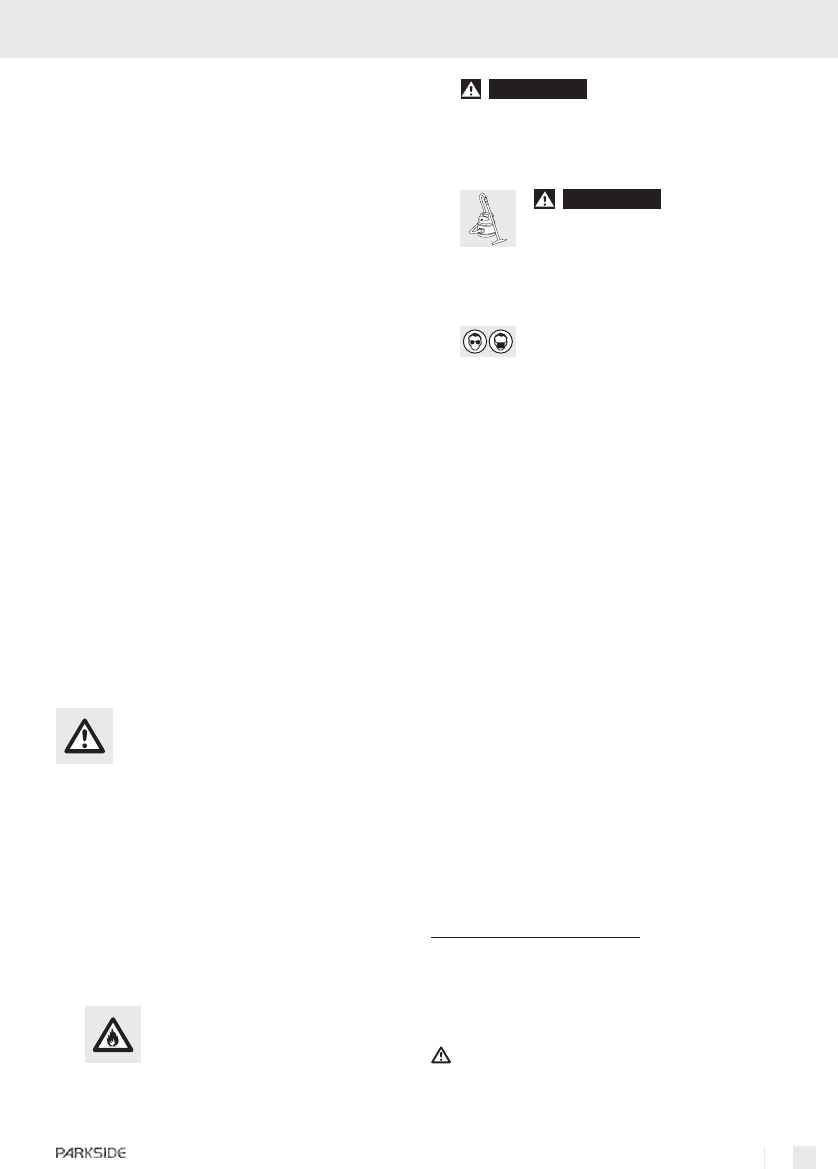
9 GB/IE/CY
General safety advice for electrical power tools / Preparing for use
d) When not in use always ensure that
electrical power tools are kept out of
reach of children. Do not let anyone
use the device if he or she is not famil-
iar with it or has not read the instruc-
tions and advice. Electrical power tools are
dangerous when they are used by inexperienced
people.
e) Look after the device carefully. Check
that moving parts are working prop-
erly and move freely. Check for any
parts that are broken or damaged
enough to detrimentally affect the
functioning of the device. Have dam-
aged parts repaired before you use the
device. Many accidents have their origins in
poorly maintained electrical power tools.
f) Use the electrical power tool, accesso-
ries, inserted tools etc. in accordance
with these instructions and advice,
and the stipulations drawn up for this
particular type of device. In doing
this, take into account the working
conditions and the task in hand. The
use of electrical power tools for purposes other
than those intended can lead to dangerous
situations.
Safety advice relating
specifically to this device
J Securely support the workpiece. Use clamps or
a vice to grip the workpiece firmly. This is much
safer than holding it in your hand.
J Never support yourself by placing your hands
near or in front of the device or the workpiece
surface. A slip can result in injury.
J If a dangerous situation arises, pull the mains
plug immediately out of the mains socket.
J Always work with the mains lead leading
away from the rear of the device.
J
DANGER OF FIRE FROM FLYING
SPARKS! Abrading metal creates
flying sparks. For this reason, always
make sure that nobody is placed in any danger
and that there are no inflammable materials
near the working area.
J
WARNING!
NOXIOUS FUMES!
Any harmful / noxious dusts generated from
sanding represent a risk to the health of the
person operating the device and to anyone
near the work area.
J
WARNING!
DUST HAZ-
ARD! When sanding wood and in
particular when working on materials
that give rise to dusts that are hazardous to
health, the sander must be connected to a suit-
able external dust extraction device.
Wear protective glasses and a dust
mask!
J Ensure that there is adequate ventilation when
working on plastic, paint, varnish etc.
J Do not soak the materials or the surface you
are about to work on with liquids containing
solvents.
J Do not abrade moistened materials or damp
surfaces.
J Avoid sanding paints containing lead or other
substances hazardous to health.
J Do not work on materials containing asbestos.
Asbestos is a known carcinogen.
J Avoid contact with the moving sanding sheet.
J Operate the device only with an attached
sanding sheet.
J Never use the device for a purpose for which it
was not intended nor with non-original parts /
accessories. The use of tools or accessories
other than those recommended in the operating
instructions could lead to you suffering an injury.
J Switch the device off and allow it to come to a
standstill before you put it down.
J Always keep the device clean, dry and free of
oil or grease.
Q
Preparing for use
Take note of the mains voltage. The mains voltage
at the mains socket must match that shown on the
rating plate on the device. Devices marked with
230 V can also be operated at 220 V.
CAUTION! Make sure that the device is
switched off before you connect it to the mains
supply.
XQ2_Handschleifer_Content_LB6.indd 9 19.03.09 14:37














